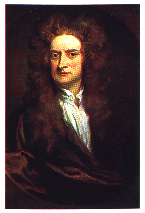| |
...........One more
champion of scientific progress was to appear during the
seventeenth century; his intellectual contributions were
the foremost factor in allowing the extension of the
human frontier beyond the earth. Isaac Newton, the father
of physics, was born in the year of Galileo's death, and
his work was to explain some of the deepest mysteries of
the universe uncovered by his predecessors stargazing.
Newton said of the extraordinary revelations laid down in
his landmark work titled Principia Mathematica
Philosophiae Naturalis: "If I have seen further
it is by standing on the shoulders of giants" (Emme,
26). This was indeed the most apt description for Newtons
unforeseen breakthroughs in the sciences. He invented the
laws of motion and gravity, created the exceptional new
reflecting telescope, and formulated the mathematical
principles of calculus, effectively combining the most
nebulous aspects of the renaissance scientists’
discoveries into one all encompassing set of natural
laws. According to astronomy professor Jerry Waxman,
"Any one of [Newton’s] achievements would have
marked a man for everlasting fame. Together, they form
the most glorious period of scientific insight in the
history of physics" (Waxman, 14). As physics is the
backbone of space age advancement, it is important to
realize the pivotal role of Newton in our study of the
origins of space travel. |
 |
| Isaac Newton, the father of
modern physics and calculus. His theories birthed
the idea that humans could orbit or depart from
the planet. |
|
